The 2013/14 Arsenal under Arsène Wenger was the clubs highest finish in the EPL since 2008. While towards the end of his tenure he was certainly viewed as past his prime, there is no denying the success he brought to the club. However, the 2013/14 year is unique in that the tactics Wenger deployed regularly utilised four and sometimes even five central midfielders.
Perhaps the most common theme within his teams at Arsenal was their ability to play fast-paced and intricate attacking football. With breathtaking goals played in brilliant 1,2 combinations as the hallmark. This tactical analysis will highlight the brilliance behind Wenger’s 2013/14 Arsenal and the key components in what made their attacking football so unique.
The 4-2-3-1
One of the crucial aspects of Wenger’s 2013/14 team was utilising the 4-2-3-1 formation. However, the group typically defended in a relatively flat 4-4-2 and would quickly shift into a diamond in the midfield gaining possession. Allowing Wenger to regularly deploy athletic and pacey outside backs in Kieran Gibbs and Bacary Sagna who would join in during attacking sequences. Utilising these tactics for outside backs also allowed Wenger to play up to 5 central midfielders on matchday. Creating numerical advantages for Arsenal in the centre of the pitch and regularly allowing them to control possession.
Another important aspect of deploying 5 central midfielders allowed for fluid movement between them all. While typically it was Mikel Arteta or Mathieu Flamini playing as the pivot or holding midfielder on matchday the entire group during that season was comfortable receiving the ball from a centre-back in low positions.
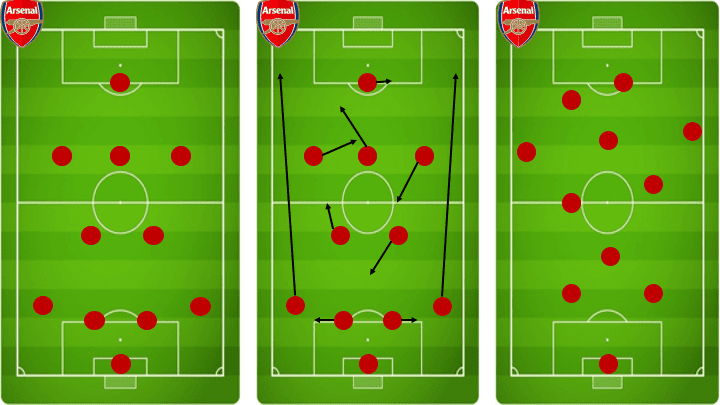
While this 2013/14 Wenger team utilised a 4-2-3-1 defensively, as soon as this team gained possession the shape quickly shifted to what we see in the picture above. The holding midfielder or ‘6’ of the group typically Arteta or Flamini would immediately drop low to receive the ball off the centre-backs while both full-backs pushed higher up the pitch.
This allows multiple options for the remaining wingers, central attacking midfielder (CAM), and centre-forward. One of the most common movements seen within this group was Mesut Özil playing as the CAM stepping higher as a second forward. Which in turn vacates the 10 space allowing for either of the wingers to move centrally, while the other drops lower to create a diamond centrally. Ultimately, creating a 2-3-2 attacking shape with Arteta sitting in front of the two centre-backs in order to prevent dangerous counter-attacks.
However, the true brilliance in deploying these tactics for this group was understanding that any player within that team could take up any of those attacking positions. He understood that he had a clever group of players that could recognise available space and exploit it as a group. Oftentimes resulting in players moving in and out of their “typical” or numerical role making them unpredictable and that much tougher to defend.
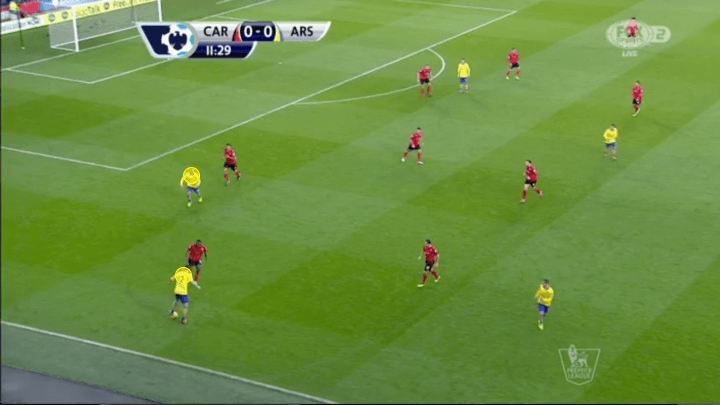
The picture above illustrates just how much movement and fluidity this group utilised. Here we see current Chelsea player Olivier Giroud, a centre-forward on the ball in the left channel. With left-back Gibbs who ran inside and took up Giroud’s normal position. While this may seem minimal and not particularly influential it was these types of movements that made this group so lethal in their attack. The reason being it required defenders to make decisions either follow their mark into spots taking them out of position creating holes for other players to run into. Or, stay put and allow the player to receive the ball facing forward passing them onto a teammate to defend as we see above.
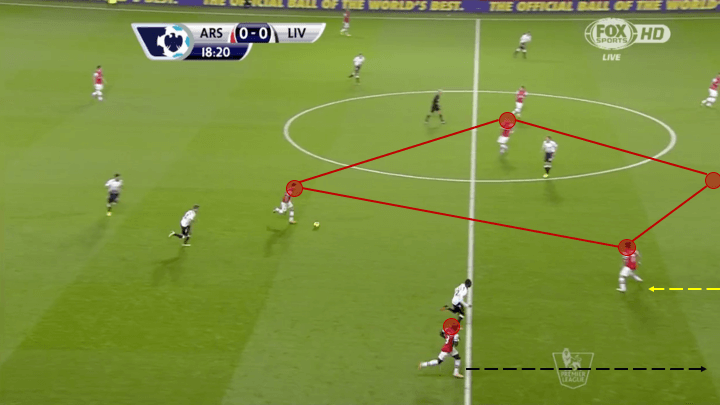
Here we see another example of this group going forward in transition. Arteta in the role as the holding midfielder dropped low to receive the ball and immediately looked to dribble forward. Thomas Rosicky the right-winger in this situation has dropped lower creating the right side of
the diamond and creating space for Sagna to go forward. Rosicky’s defender in this sequence stays tight to him creating an opportunity for Arteta to play Sagna in behind. Ultimately, resulting in Sagna serving a brilliant cross to a late-arriving Santi Cazorla who was able to finish on the volley.
Utilising two 10s
While Wenger’s decision to utilise groups of four and five central midfielders is what allowed this group to control possession in matches. It was his decision to utilise two 10’s in combination with their attacking principles that created their brilliance going forward. The genius in allowing one of the 10’s to sit higher almost as a second forward and allowing a winger to then take up the natural 10 position was vital in their creative fluid attacking style. It also allowed opportunities for players such as Özil, Cazorla, and Rosicky to take turns in defending as a central midfielder. Therefore, splitting the defensive work in half for each player and in turn allowing them both to be as effective and fresh as possible when they were able to transition into possession and attacking sequences.
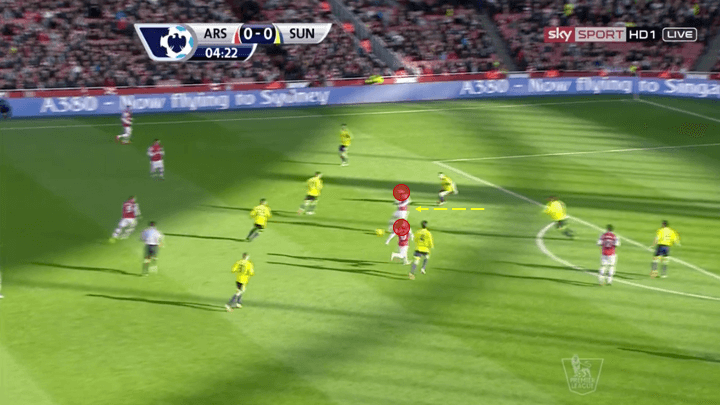
This sequence shows just how effective utilising the two 10’s was for this group. In this situation, Rosicky has checked off the backline operating in the second forward 10 role. Meanwhile, Jack Wilshere has taken up the top of the diamond 10 space centrally providing support for Rosicky. This run allows Rosicky to play one-touch to Wilshere who was able to find Giroud in the box who slots the ball just inside of the near post with a left-footed strike.

Here we see it again from Rosicky and Wilshere except for this time their positions have changed slightly. Here Wilshere is operating in the second forward 10 role while Rosicky is on the ball has now become the right side of the midfield diamond. Meanwhile, Cazorla has shifted centrally too and has taken up the typical 10 space centrally. Again these sequences are tough to defend as these players are all exchanging within that midfield diamond. Constantly, asking the opposing defenders to make decisions to either stay tight and marked or allow the Arsenal midfielders to find spaces and time on the ball regularly.
Quick 1, 2’s around the box
Wenger’s trust in this group, utilising so many different combinations of central midfielders was a testament to the type of player he recruited for the club. Looking for the correct combination of athletic, technical, and most importantly intelligent players is what allowed his attacking style to flourish at Arsenal. During this 2013/14 season the way in which Arsenal looked to get in behind opponents’ backline in possession, was through the use of quick 1,2’s near their opponents 18-yard box.
This specific tactic required several important aspects which the players needed to recognize. The first was regardless of who the player was, they regularly needed someone to post up on the opposing centre-backs to anchor and occupy that space between them. This was typically Giroud or another of the centre-forwards but even at times throughout the season players like Özil, Cazorla, and Ramsey would find themselves in that position. Once in the attacking third
with a player posted up on the centre-backs, the next component was to get someone on the ball running at that player. This, in turn, would create opportunities to play into the deeper post up player such as Giroud. From there it was up to the remaining players to run off of the post up man and look for one-touch lay-offs or through passes in behind the defence. When done correctly it created the best attacking sequences for Arsenal during the season. Providing fans regularly with those moments of being on the edge of their seats waiting for the ball to ripple the back of the opponent’s goal.
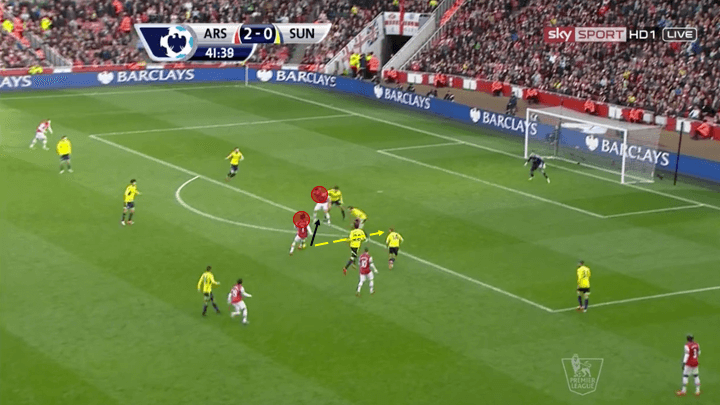
This sequence shows Rosicky who’s in an advanced position and recognises Giroud is posted up occupying both centre-backs. As such he is able to combine with Wilshere and is now on the dribble towards Giroud. He dribbles towards Giroud to engage the nearest centre-back and upon him stepping to Rosicky on the ball, he plays a brilliant 1,2 with Giroud at the top of the box.
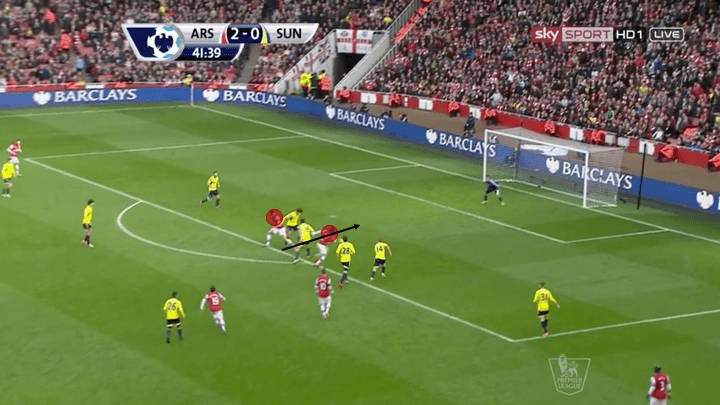
Giroud recognising he is inside the 18-yard box is able to comfortably play a one-touch pass back to the forward running Rosicky. Giroud’s deep position here is crucial as it puts the defenders in a dangerous position as if they step too tightly or try to win the initial pass from Rosicky they pose the risk of giving up a penalty. Still, the quality from Giroud to hold off his defender and play an outside of the foot flick in behind is incredible.
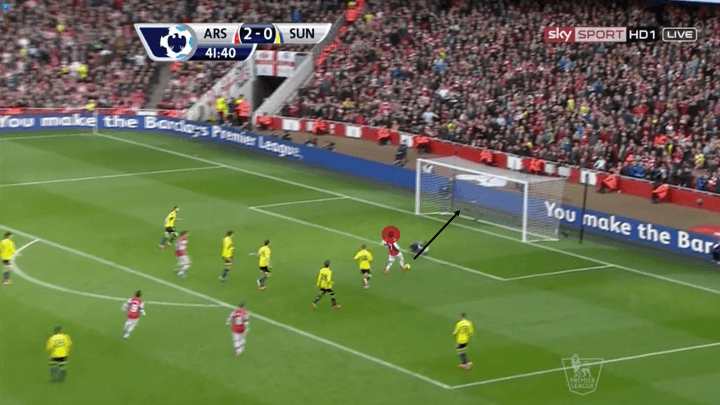
Here we see the result which is Rosicky receiving the ball 1v1 with the goalkeeper 8 yards from the goal. Rosicky calmly lifts the ball above the diving goalkeeper and completes this devastating 1,2 with Giroud to provide them with another goal.
Another brilliant example of this came in Arsenal’s win against Norwich, with perhaps one of the clubs most famous goals to date.
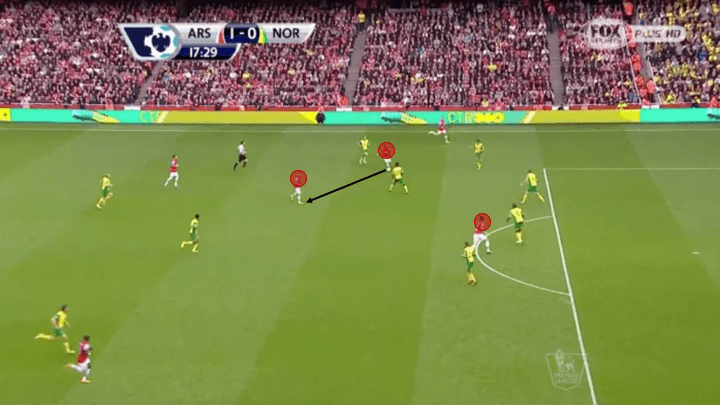
In a similar situation, we see Cazorla who’s dribbled inside and looks to pass the ball centrally.
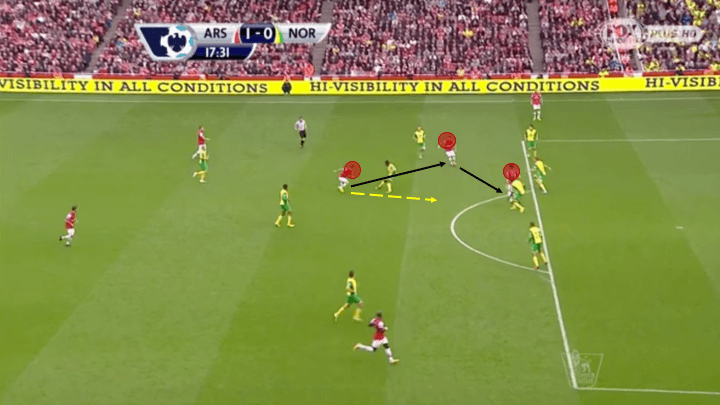
Wilshere receives the ball, engages his defender and plays the ball back to Cazorla looking for a 1,2. Meanwhile, Giroud has taken his post-up position between the two centre-backs at the top of the box. Cazorla receives the ball and plays a well-weighted 1-touch pass to Giroud.
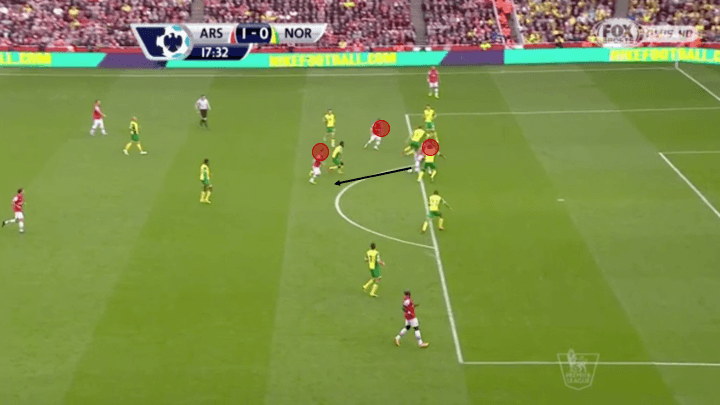
Giroud recognising he’s pulled both centre-backs towards him plays another great one-touch ball to the forward running Wilshere.
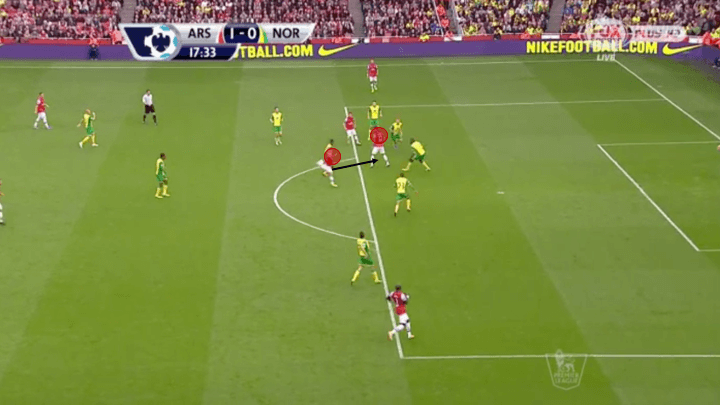
It’s a difficult pass from Giroud which is high and behind Wilshere who flicks the ball back to Giroud in one touch as well.
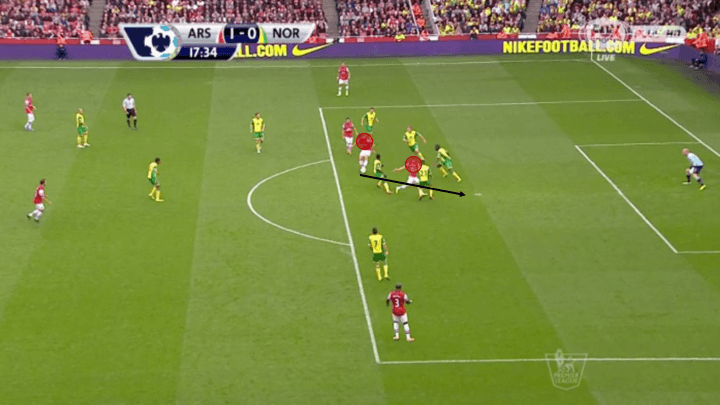
Giroud again receives and plays an outside of the foot pass in one touch, to Wilshere who is now at full speed in behind the opponent’s backline.
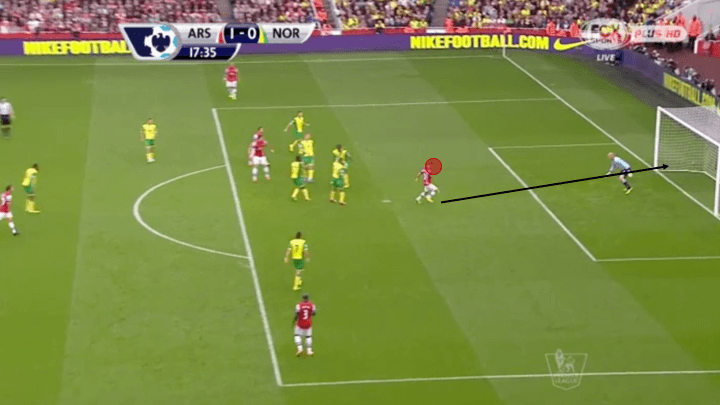
From here Wilshere is in 1v1 similar to Rosicky, and himself finishes with a first-time volley towards the near post.
This sequence again works because of the running from Wilshere and the positioning of Giroud. Their ability to play one-touch passes in the tight spaces comes down to their quality as players. However, the principles with this play are clear.
Wilshere engages his defender uses Giroud as a post up and then knows Giroud will be looking to play him in behind in one touch. The recognition from both players here is brilliant. As is Cazorla’s ability to begin the play by progressing forward as the left side of the midfield diamond on the dribble allowing Wilshere to get into that central 10 space. It’s clear that when worked correctly, with their quality this Arsenal group scored absolutely mesmerising 1 and 2 touch goals. While Wenger may not have drawn this one up exactly so, the principles behind the movements of each player have his DNA all over them.
Conclusion
This analysis was to show how the creativity of this Arsenal team in 2013/14 was a product of Wenger’s genius as a manager. He recruited a group of high IQ, athletic, and technically gifted players. He gave them the parameters in which he wanted them to attack other teams. Utilising one centre-forward and two 10’s or playmakers and surrounding them with central midfielders who always wanted the ball. Add in full-backs who understood where available space was to go forward either wide or inside and it created a fluid attacking style that we may never see replicated. His genius was truly in the tactics.
This group had enough creative players that they didn’t need to play the phase by phase methodic football we see. Most of all it had players constantly changing positions on the field based on where space was available to attack. It made them unpredictable and tough to defend. At times they suffered when the quality wasn’t there to finish off their chances. But at the end of the day, they were footballers and not robots playing a position. The goals they produced ended emphatically, with wide eyes, and smiles from ear to ear. Arsène Wenger gave them the car and said here are the keys. At the end of the day, that’s how football should be played attacking, creative, unpredictable, and ultimately with the handbrake off.






Comments